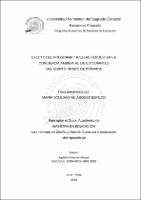Efecto del programa “huellas verdes” en la conciencia ambiental de estudiantes del quinto grado de primaria
Abstract
El presente estudio tuvo como objetivo verificar el efecto del programa "Huellas Verdes" en la conciencia ambiental de los estudiantes de quinto grado de primaria de una Institución Educativa Estatal de Chosica. La investigación es cuantitativa, de nivel explicativo o de comprobación de hipótesis causales; el tipo de investigación sustantiva en la modalidad explicativa y el diseño es experimental, específicamente cuasiexperimental. El instrumento utilizado fue la Escala de Conciencia Ambiental de creación propia. La muestra fue de 33 estudiantes en el grupo experimental y 27 en el grupo de control. En el post test los participantes muestran mejores resultados en la dimensión disposicional con 94,79% de logro y en la dimensión afectiva con 93,93% de logro. Mientras que en la dimensión cognitiva muestran el 91,83% de logro y en la dimensión activa, el 88,69% de logro. El análisis de esta problemática ambiental deja abierta la posibilidad de realizar investigaciones para sumar acciones significativas en beneficio de la tierra afectada por las huellas nefastas de la depredación y contaminación. This thesis deals about the development and strengthening of environmental awareness in all its dimensions, so that students become aware of their role as agents of change in the face of environmental problems. The main objective is to verify the effect of the "Green Footprints" program on the environmental awareness of the fifth grade elementary students from the state educational institution in Chosica. The research is quantitative, explanatory level or testing of causal hypotheses; the type of research is substantive in the explanatory modality and the design is experimental, specifically quasi-experimental. The instrument used is the self-created Environmental Awareness Scale. The sample was 33 students in the experimental group and 27 in the control group. In the post test, the participants show better results in the dispositional dimension with 94.79% of achievement and in the affective dimension with 93.93% of achievement. While in the cognitive dimension they show 91.83% of achievement and in the active dimension, 88.69% of achievement. The analysis of this environmental problem leaves open the possibility of deepening the investigations to add significant actions for the benefit of the Earth affected by the harmful traces of predation and contamination.
Description
Tesis


